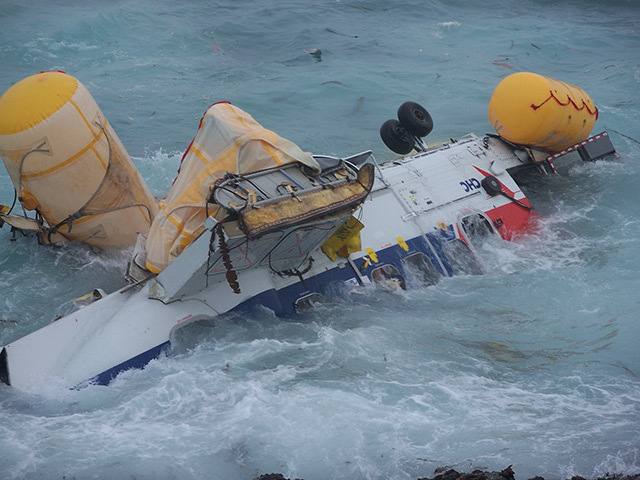
The shocking loss of yet more personnel in a Super-Puma incident in the UK sector once again highlights why so many offshore workers are worried out commuting offshore.
It may finally drive home the danger of placing too much emphasis on one aircraft model; brand too.
Had the CHC helicopter that went down on August 23 and which apparently did not disintegrate on impact, ditched even only 10 miles off Shetland and not close in, there might have been even more deaths. As it is, four is too many.
There remain many in this industry who experienced the Chinook era in the North Sea. It was terminated in 1986 by a shocking accident that put paid to that aircraft on UK Continental Shelf service.
Will this be the Puma’s fate too?
Helicopter transportation is statistically very safe, albeit not as good as fixed wing aircraft and rail transportation. That can only be expected because of the highly complex nature of these machines .
To be fair, lessons have been learned along the years each time there has been an incident. The ongoing battle to solve the inherent failings of the EC225 variant of the Super-Puma demonstrates this.
But once again the L2 model is in the spotlight . . . less than five years after the crash of April 1, 2009, when all 16 on board perished.
But is it just the aircraft, or is there something systemically wrong with the way in which the CAA polices civil helicopters?
Sintef, a respected research body in Norway, has carried out an in-depth analysis of helicopter safety in the UK and Norwegian sectors cov ering the years 1990 through 2009.
It published a highly detailed 181-page report: SINTEF A15753 in March 2010. It’s a very tough read and certain bits stand out, like a table of data on p67.
It’s a summary of traffic and accident statistics covering the UKCS and NCS. And it’s startling.
Over the period 1990-1998, 5.3million person flight hours were recorded for the Norwegian sector versus 10.5million for the UK.
There were four accidents (one fatal) on the NCS versus 11 (two fatals) on the UKCS.
During 1999-2009, 7.8million hours are recorded for the NCS compared with 13.9million for the UKCS.
There was just one accident on the NCS compared with 11 on the UKCS; both recorded three fatals.
For the 20-years, 13.1million hours were recorded for the NCS versus 16.6million for the UKCS.
As for accidents, the Norwegian total is five; but 22 in the UK sector.
And the number of fatalities per million man-hours for 1990 through 2009 is 0.9 (Norway) and 3.1 (UK). Why is there such a difference between Norway and the UK; why is the British record seemingly a lot worse than its neighbour?
There can be no such thing as a straightforward answer, not least because, behind every incident is a suite of what the industry calls RIFs . . . risk influencing factors.
Three very important ones are aircraft design, continuous airworthiness and pilot competence. Weather, technician dependability and aircraft technical dependability are further significant RIFs. There are many more.
Sintef makes recommendations on improving aircraft safety. I suggest you find the report on the Internet. There’s a passage that stands out for me on p155.
Besides revitalising the Committee for Helicopter Safety on the Norwegian Continental Shelf, it says: “During the interviews and expert judgements in HSS-3, there have been clear signals from several parties that the time is right for revitalising the further work on improving the safety of this type of transportation. The most concrete suggestion involves revitalising the committee through establishing a technical helicopter centre, most likely at Sola. One precondition for such a centre to function efficiently will be providing decision-making authority and continuity.”
I wonder if the numbers on page 67 of the Sintef report point to systemic issues here in the UK with regard to the way in which the CAA does its work. Or is it just bad luck?
The offshore industry has its Helicopter Safety Steering Group and has done much to mitigate various operational risk factors. But do we need to do much more?
I believe so and helicopter safety will be a huge talking point at this year’s Offshore Europe which was already primed to suffer an all-time high for political meddling.
August 23’s disaster ensures that.
Turning to politicians attending, ye gods, what a line-up:
First minister Alex Salmond who will doubtless hammer home Scotland’s claim to oil resources should his bid for independence succeed.
Lord Green, the gentlemanly and current UK minister for trade and investment.
The latest of too many UK energy ministers, Michael Fallon who I have yet to meet.
Scottish energy, etc, minister, the redoubtable Fergus Ewing.
Sajid Javid, economic secretary to the Treasury… faceless to me.
Business secretary Vince Cable, ex back office boy at Shell.
Mystery man… it was presumed to be either PM David Cameron or Treasury raider-in-chief/chancellor George Osborne; however, a late addition is energy sec, Ed Davey.
You can bet there will be lots of point scoring at this year’s show.
And that’s a pity because it will do the industry little good, IMO.
Recommended for you
